Kastilien-Leon |
|
|
|
| Übersicht – Contents: | |
Diese Seite ist Teil des Projektes
Kastilien-Leon |
|
|
|
| Übersicht – Contents: | |
Flagge – Flag: |
|
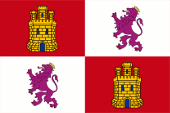 |
seit/since 1980, |
| historische und andere Flaggen – historical and other Flags: | |
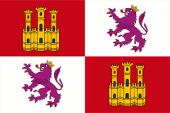 |
1230–1479, |
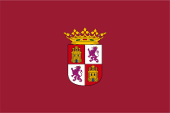 |
1978–1980, |
| Die heutige Flagge der spanischen autonomen Gemeinschaft Kastilien und León wurde am 25.02.1983 per Gesetz eingeführt. Sie zeigt das Design der Flagge des alten Königreichs Kastilien-Leon, das bis 1479 bestand. Die Flagge des alten Königreichs Kastilien-Leon war, wie damals üblich, eine Wappenflagge. Das heißt, eine Flagge die das Bild des Wappens des Landes (eigentlich des Herrschers) zeigte. Das Flaggentuch ist gevierteilt und zeigt eine Kombination der Heraldik von Kastilien und von Leon: Burg und Löwe. Dieses Design entstand im Jahre 1230 durch die Vereinigung der Kronen beider Länder. Durch die Gründung des spanischen Staates im Jahre 1479 rückte die Symbolik des Königreichs Kastilien-Leon in den Hintergrund. Natürlich erschienen Burg und Löwe über die Jahrhunderte in immer wieder anderer Gestalt, dem Zeitgeschmack unterworfen, denn Vorgaben oder Vorschriften über die exakte Ausführung der Bilder gab es damals noch nicht. Das heutige Erscheinungsbild steht jedoch seit 1983 fest. Unter der der Regierung des Generals Franco (1936–1975) waren jedoch alle regionalen Flaggen verboten. Nach Francos Tod (1975) wurden die regionale Flaggen eingeführt oder wieder eingeführt. Im Jahre 1978 führten Neukastilien (Kastilien-La Mancha) und Altkastilien (Kastilien-Leon) eigene Flaggen ein, wenn auch zunächst inoffiziell, da beide Länder bis 1982/83 noch keinen Autonomiestatus hatten. Die Macht und Kultur von Kastilien-Leon prägten ganz Spanien über Jahrhunderte. Besonders seit den 70-er Jahren des 20. Jahrhunderts besannen sich aber alle Bestandteile des spanischen Staates ihrer eigentlichen kulturellen Herkunft und entwickelten Autonomiebestrebungen, die eigentlich eine Bewegung weg vom dominierenden Kastilien war. So wurde 1978, vor dem heutigen Modell, zunächst eine andere Flagge eingeführt. Sie ging auf ein Banner aus dem 16. Jahrhundert zurück, war einfarbig purpur und trug das Wappen des Landes in der Mitte. Schon um 1980 besann man sich in Kastilien-Leon seiner Tradition und reaktivierte die ursprüngliche Symbolik von Kastilien-Leon aus dem 15. Jahrhundert. Die einfarbig purpurne Flagge gilt jedoch bis heute als Banner des Landes. |
The current flag of the
Spanish autonomous community of Castile and Leon was introduced by law on 25
of February in 1983. It shows the design of the flag of the old kingdom of
Castile-Leon, which existed until 1479. The flag of the old kingdom of Castile-Leon was, as was customary at the time, a flag of arms. That is, a flag that displayed the image of the coat of arms of the country (actually the ruler). The flag cloth is quartered and shows a combination of the heraldry of Castile and of Leon: castle and lion. This design was created in 1230 by the union of the crowns of the two countries. With the foundation of the Spanish state in 1479, the symbolism of the kingdom of Castile-Leon receded into the background. Of course, over the centuries, the castle and the lion have always appeared in different guises, subject to the taste of the times, because there were no specifications or regulations about the exact design of the images at that time. Today's appearance, however, has been fixed since 1983. However, under the government of General Franco (1936-1975), all regional flags were banned. After Franco's death (1975), regional flags were introduced or reintroduced. In 1978, New Castile (Castile-La Mancha) and Old Castile (Castile-Leon) introduced their own flags, albeit unofficially at first, as neither had autonomous status until 1982/83. The power and culture of Castile-Leon shaped the whole of Spain for centuries. However, especially since the 1970s, all the components of the Spanish state began to reflect on their actual cultural origins and developed autonomy aspirations, which was actually a movement away from the dominant Castile. Thus, in 1978, before the current model, a different flag was initially introduced. It went back to a 16th century banner, was plain purple and bore the country's coat of arms in the centre. As early as around 1980, Castile-Leon recalled its tradition and reactivated the original symbolism of Castile-Leon from the 15th century. However, the plain purple flag is still considered the country's banner today. |
| Quelle/Source: Wikipedia (DE), Flags of the World, Volker Preuß | |
Wappen – Coat of Arms: |
|
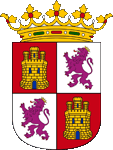 |
seit/since 1978, Wappen von Kastilien-Leon – coat of arms of Castile-Leon, Quelle/Source, nach/by: Heralder], some elements by Rastrojo, CC BY-SA 3.0, via Wikimedia Commons |
historische Wappen – historical Coats of Arms: |
|
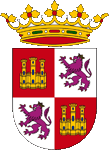 |
ab/from 13. Jahrhundert / 13th century, Wappen des Königreichs Kastilien-Leon – coat of arms of the Kingdom of Castile-Leon, Quelle/Source, nach/by: Wikipedia (DE), Flags of the World |
| Das heutige Wappen der spanischen autonomen Gemeinschaft Kastilien und León wurde für die Region wahrscheinlich 1978 wiedereingeführt und am 25.02.1983 per Gesetz bestätigt, als die autonome Gemeinschaft gegründet wurde. Es zeigt das Design des Wappens des alten Königreichs Kastilien-Leon, das bis 1479 bestand. Es war gevierteilt und zeigte eine Kombination der Heraldik von Kastilien und von Leon: Burg und Löwe. Dieses Design entstand im Jahre 1230 durch die Vereinigung der Kronen beider Länder. Natürlich erschienen Burg und Löwe über die Jahrhunderte in immer wieder anderer Gestalt, dem Zeitgeschmack unterworfen, denn Vorgaben oder Vorschriften über die exakte Ausführung der Bilder gab es damals noch nicht. Das heutige Erscheinungsbild steht jedoch seit 1983 fest. |
The current coat of arms
of the Spanish autonomous community of Castile and Leon was probably
reintroduced for the region in 1978 and confirmed by law on 25th of February in 1983, when
the autonomous community was founded. It shows the design of the coat of arms of the old kingdom of Castile-Leon, which existed until 1479. It was quartered and showed a combination of the heraldry of Castile and Leon: castle and lion. This design was created in 1230 by the union of the crowns of the two countries. Of course, over the centuries, the castle and the lion have always appeared in different guises, subject to the taste of the times, because there were no specifications or regulations about the exact design of the images at that time. Today's appearance, however, has been fixed since 1983. |
| Quelle/Source: Wikipedia (ES), Volker Preuß | |
|
Die autonomen Regionen Spaniens – The autonomous Regions of Spain: Interaktive Landkarte - interactive map |
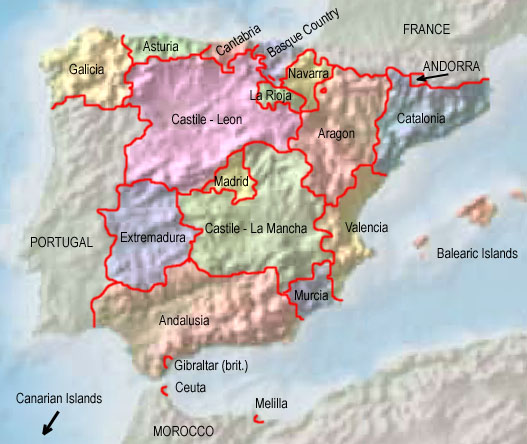 |
| Quelle/Source: Freeware, University of Texas Libraries, modyfied by: Volker Preuß |
|
Karte der historischen Königreiche auf der Iberischen Halbinsel (ca. 1220) – Map of the historical Kingdoms on the Iberian Peninsula (ca. 1220): Interaktive Landkarte - interactive map |
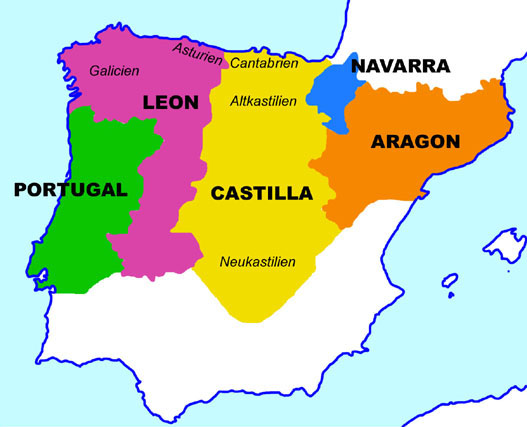 |
| Landkarte/map by: Volker Preuß |
| Zahlen und Fakten – Numbers and Facts: | |
|
|
|
|
|
|
|
|
|
|
|
|
|
|
|
|
| Das Königreich Kastilien-Leon entstand im Jahre 1230 durch die Vereinigung der Kronen der beiden Königreiche Kastilien (← hier klicken) und Leon (← hier klicken). Kastilien wurde der wichtigste und Hauptbestandteil des Königreichs Kastilien-Leon. |
|
1230–1252
· Herrschaft von König Ferdinand III. (der Heilige), sehr erfolgreiche
Kämpfe im Befreiungskrieg gegen die Araber, Ausdehnung von Kastilien-Leon
bis an die Südküste Spaniens im Atlantik und Mittelmeer 1236 · Befreiung von Córdoba von den Arabern, Gründung des Kastillischen Königreichs Córdoba 1243 · die Stadt Murcia wird durch Alfons X. von Kastilien und seinen Truppen von den Arabern befreit, Gründung des Kastillischen Königreichs Murcia 1248 · Befreiung von Sevilla von den Arabern, Gründung des Kastillischen Königreichs Sevilla 1248 · Befreiung von Cartagena von den Arabern 1252–1284 · Herrschaft von König Alfons X. (der Weise), Sohn von Ferdinand III., Thronfolgestreitigkeiten zwischen seinen Söhnen Ferdinand (Erstgeborener) und Sancho (Zweitgeborener) 1284–1295 · Herrschaft von König Sancho IV. (Sohn von Alfons X.), Adelsrevolten 1295–1312 · Herrschaft von König Ferdinand IV. (Sohn von Sancho IV.), Adelsrevolten, Angriffe der benachbarten Königreiche, die Regentin Maria de Molina (Mutter des minderjährigen Ferdinand IV.) kann Kastilien-Leon bewahren 1312–1350 · Herrschaft von König Alfons XI. (Sohn von Ferdinand IV.), Adelsrevolten, Machtkämpfe, Angriffe der benachbarten Königreiche, Bürgerkrieg 1344 · Befreiung von Algeziras von den Arabern 1350–1369 · Herrschaft von König Peter dem Grausamen (Sohn von Alfons XI.), finstere Herrschaft voller Grausamkeit und Greueltaten, Aufstände, Revolte seines Halbbruders Heinrich von Trastamara 1369 · Schlacht von Montiel, König Peter wird von Heinrich getötet 1369–1379 · Herrschaft von König Heinrich II. (Halbbruder von Peter dem Grausamen), Thronstreitigkeiten mit Peters Schwiegersohn Johann von Lancaster 1379–1390 · Herrschaft von König Johann I. (Sohn von Heinrich II.), Krieg gegen Portugal und das englische Haus Lancaster 1387 · Vertrag von Bayonne, Friede mit England 1389 · Friede mit Portugal 1390–1406 · Herrschaft von König Heinrich III. (Sohn von Johann I.), auf Grund von Minderjährigkeit zunächst unter einem Regenten, daher Schwierigkeiten in der Verwaltung des Reiches 1393 · König Heinrich III. erklärt sich für mündig, Heirat mit Catharine von Lancaster 1402 · Inbesitznahme der Kanarischen Inseln durch Kastilien-Leon 1406–1454 · Herrschaft von König Johann II. (Sohn von Heinrich III.), auf Grund von Minderjährigkeit zunächst unter einem Regenten 1439 · Unruhen, Aufstände 1454–1474 · Herrschaft von König Heinrich IV., dem Ohnmächtigen, (Sohn von Johann II.), Erbfolgeprobleme, Aufstände, Adelsrevolten 1462 · Befreiung von Gibraltar von den Arabern 1465 · Aufstände, Adelsrevolte, der Adel ernennt Alfons, den 11-jährigen Bruder von Heinrich IV. zum König, Bürgerkrieg 1468 · Tod von Alfons, der Adel proklamiert Isabella, die Schwester von Heinrich IV. zur Königin (Isabella I.) |
| Im Jahre 1469 heiratet Isabella I., Königin von Kastilien-León Ferdinand II., den Prinzen und Thronfolger von Aragónien. Beide werden 1479 zu Königen von Spanien gekrönt, und somit Kastilien-Leon und Aragónien zu einem einzigen Land vereinigt. Das mächtige und alte Kastilien wird damit zum Hauptbestandteil Spaniens und wird prägend für die spanische Kultur. |
|
11.12.1474
· Tod von Heinrich IV., Ende des Bürgerkriegs, Isabella I. wird als Erbin
von Kastilien-Leon bestätigt, Portugal erhebt Ansprüche auf den Thron, Krieg
Portugals und Frankreichs gegen Kastilien-Leon 1476 · Schlacht bei Toro, Niederlage der Portugiesen 1479 · Friede von Alcantara, Portugal erkennt Isabella als Königin von Kastilien-Leon an 1479 · Tod von König Johann II. von Aragonien, Nachfolger ist Ferdinand II., Gemahl von Königin Isabella I., Vereinigung der Kronen von Aragonien und Kastilien-Leon, Krönung von Ferdinand II. und Isabella I. zu Königen von Spanien 1492 · Eroberung des Emirats von Granada durch Spanische Truppen, damit Beseitigung des letzten Brückenkopfes der Araber auf Europäischem Gebiet, Christoph Columbus entdeckt Amerika, Beginn des spanischen Kolonialzeitalters, Aufstieg Spaniens zur Weltmacht 1808–1813 · Kastilien ist durch französische Truppen besetzt 1833 · die bis dato in Spanien bestehenden Teilkönigreiche und Regionen werden in Provinzen aufgeteilt, auch Altkastilien und Leon, und zwar in die Provinzen León, Zamora, Salamanca, Palencia, Burgos, Logroño, Valladolid, Avila, La Granja und Soria 1936–1939 · Spanischer Bürgerkrieg, Alt-Kastilien und Leon (das heutige Kastilien-Leon) kämpft an der Seite der Franco-Truppen gegen die sozialistische Zentralregierung, Neu-Kastilien (das heutige Kastilien-La Mancha) kämpft teilweise und vereinzelt bis 1939 auf Seiten der sozialistischen Regierungstruppen 25.03.1983 · Kastilien-Leon erhält das Autonomiestatut innerhalb Spaniens (unter Zusammenfassung der Provinzen León, Zamora, Salamanca, Palencia, Burgos, Valladolid, Avila, La Granja und Soria), Gründung der "Autonomen Gemeinschaft Kastilien und Leon" |
| The Kingdom of Castile-Leon came into being by unification of the crowns of the both Kingdoms Castile (← click here) and Leon (← click here) in the year 1230. Castile became to the most important and main component of the Kingdom of Castile-Leon. |
|
1230–1252
· reign of King Ferdinand III. (the Saint), very successful battles in the
liberation war against the Arabs, expansion of Castile-Leon to the southern
coast of Spain at Atlantic Ocean and Mediterranean Sea 1236 · liberation of Córdoba from the Arabs, establishment of the Castilian Kingdom of Córdoba 1243 · Murcia Town becomes liberated from the Arabs by Alfons X. of Castile and his troops, establishment of the Castilian Kingdom od Murcia 1248 · liberation of Sevilla from the Arabs, establishment of the Castilian Kingdom of Sevilla 1248 · liberation of Cartagena from the Arabs 1252–1284 · reign of King Alfons X. (the Wise), he is a son of Ferdinand III., throne succession quarrels between his sons Ferdinand (first-born) and Sancho (second-born) 1284–1295 · reign of King Sancho IV. (son of Alfons X.), nobility revolts 1295–1312 · reign of King Ferdinand IV. (son of Sancho IV.), nobility revolts, attacks of the neighbouring kingdoms, the regent Maria de Molina (mother of the infant Ferdinand IV.) is able to preserve Castile-Leon 1312–1350 · reign of King Alfons XI. (son of Ferdinand IV.), nobility revolts, struggles for power, attacks of the neighbouring kingdoms, civil war 1344 · liberation of Algeziras from the Arabs 1350–1369 · reign of King Peter the Cruel (son of Alfons XI.), sinister rule full of cruelty and atrocities, revolts, revolt of his half-brother Henry of Trastamara 1369 · Battle of Montiel, King Peter becomes killed by Henry 1369–1379 · reign of King Henry II. (half-brother of Peter the Cruel), throne quarrels with Peters son-in-law Johann of Lancaster 1379–1390 · reign of King Johann I. (son of Henry II.), war against Portugal and the English dynasty of Lancaster 1387 · Treaty of Bayonne, peace with England 1389 · peace with Portugal 1390–1406 · reign of King Henry III. (son of Johann I.), because of his infancy initially under a regent, from there problems in the administration of the empire 1393 · King Henry III. declares hiself the majority age, marriage with Catharine of Lancaster 1402 · appropriation of the Canary Islands by Castile-Leon 1406–1454 · reign of King Johann II. (son of Henry III.), because of his infancy initially under a regent 1439 · agitations, riotings 1454–1474 · reign of King Henry IV., the Unconscious, (son of Johann II.), succession problems, riotings, nobility revolts 1462 · liberation of Gibraltar from the Arabs 1465 · riotings, nobility revolt, the nobility designates Alfons, the 11 years old brother of Henry IV. to the king, civil war 1468 · death of Alfons, the nobility proclaims Isabella, the sister of Henry IV. to the queen (Isabella I.) |
| Isabella I. Queen of Castile-Leon marrys Ferdinand II., the Prince and Throne-Successor of Aragon in the year 1469. They both become crowned to the Kings of Spain in 1479 and in this way Castile-Leon and Aragon become united to one country. The mighty and old Castile-Leon becomes in this way to the main component of Spain and becomes shaping for the Spanish culture. |
|
11th of December 1474 · death of Henry IV., end of the civil war,
Isabella I. becomes confirmed as heiress of Castile-Leon, Portugal claims
the throne, war of Portugal and France against Castile-Leon 1476 · Battle of Toro, defeat of the Portugese 1479 · peace of Alcantara, Portugal recognizes Isabella as queen of Castile-Leon 1479 · death of King Johann II. of Aragon, successor is Ferdinand II., husband of queen Isabella I., unification of the crowns of Aragon and Castile-Leon, coronation of Ferdinand II. and Isabella I. to the Kings of Spain 1492 · conquest of the Emirate of Granada by Spanish troops, in this way elimination of the last bridgehead of the Arabs on European territory, Christoph Columbus discovers America, start of the Spanish colonial era, rise of Spain to the world power 1808–1813 · Kastilien is occupied by French troops 1833 · the until that point in time in Spain existing partial kingdoms and regions become divided in provinces, Old Castile and Leon too, namely in the provinces of León, Zamora, Salamanca, Palencia, Burgos, Logroño, Valladolid, Avila, La Granja and Soria 1936–1939 · Spanish civil war, Old Castile and Leon (the today's Castile-Leon) fights on the side of the troops of General Franco against the socialistic central government, New Castile (the today's Castile-La Mancha) fights partially and until 1939 on the side if the socialistic governmental troops 25th of March 1983 · Castile-Leon gets the statute of autonomy within Spain (by summary of the provinces of León, Zamora, Salamanca, Palencia, Burgos, Valladolid, Avila, La Granja and Soria), establishment of the "Autonomous Community of Castile and Leon" |
| Quelle/Source: Wikipedia (ES), World Statesmen, RetroBib Retrobibliothek, Volker Preuß |
| Der Name "Kastilien-Leon" ist eine Kombination der Namen der beiden Regionen "Kastilien" und "Leon". | The name
"Castile-Leon" is a combination of the names of the two regions "Castile"
and "Leon". |
| Quelle/Source: Volker Preuß | |